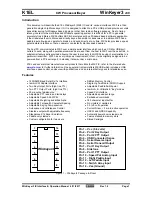
217
SDRL must be written or read only after data transmission or reception is complete. If this register
is read or written while a data transfer is in progress, the data contents are not guaranteed.
The SDRL value upon reset is not fixed.
10.2.3
Operation
Data can be sent and received in an 8-bit or 16-bit format, synchronized to an internal or external
clock. Overrun errors can be detected when an external clock is used.
(1) Clock
The serial clock can be selected from a choice of eight internal clocks and an external clock. When
an internal clock source is selected, pin SCK
1
becomes the clock output pin. When continuous
clock output mode is selected (SCR1 bits SNC1 and SNC0 are set to 10), the clock signal (ø/1024
to ø/2) selected in bits CKS2 to CKS0 is output continuously from pin SCK
1
. When an external
clock is used, pin SCK
1
is the clock input pin.
(2) Data transfer format
Figure 10.2 shows the data transfer format. Data is sent and received starting from the least
significant bit, in LSB-first format. Transmit data is output from one falling edge of the serial
clock until the next falling edge. Receive data is latched at the rising edge of the serial clock.
SCK
SO /SI
1
1
1
Bit 0
Bit 1
Bit 2
Bit 3
Bit 4
Bit 5
Bit 6
Bit 7
Figure 10.2 Transfer Format
(3) Data transfer Operations
Transmitting: A transmit operation is carried out as follows.
1. Set bits SO1 and SCK1 in PMR2 to 1, selecting the SO
1
and SCK
1
pin functions. If necessary,
set bit POF1 in PMR2 for NMOS open drain output at pin SO
1
.
2. Clear bit SNC1 in SCR1 to 0, and set bit SNC0 to 1 or 0, designating 8- or 16-bit synchronous
transfer mode. Select the serial clock in bits CKS3 to CKS0. Writing data to SCR1 initializes
the internal state of SCI1.
3. Write transmit data in SDRL and SDRU, as follows.
8-bit transfer mode:
SDRL
16-bit transfer mode: Upper byte in SDRU, lower byte in SDRL
4. Set the SCSR1 start flag (STF) to 1. SCI1 starts operating and outputs transmit data at pin SO
1
.
















































